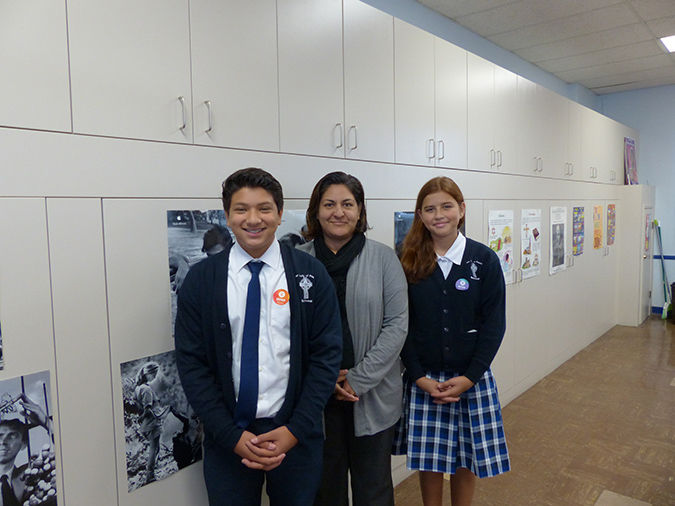Students at Our Lady of Peace School in North Hills are reaping the benefits of a summer’s worth of improvements to their nearly 60-year-old brick campus, recently experiencing an uptick in enrollment that is part of an annual student increase trend occurring in archdiocesan elementary schools over the past three years.
Lourdes Jasso, OLP principal since 2010 — the last year of a nearly decade-long decline in archdiocesan elementary school enrollment which bottomed out at 51,477 and now stands at 53,062 — credits OLP’s 20-student increase from a year ago to marketing outreach efforts that have raised the school’s profile within and without the parish.
“We’ve finally made a statement that we’re here,” said Jasso, of the 200-student preschool through eighth grade school, where 70 percent of the predominately minority students from low-income families receive tuition assistance.
Julie R. Picot, OLP’s director of marketing and development whose position is funded through a grant from the Specialty Family Foundation, has helped to raise the school’s profile since she came on board 15 months ago after moving from her home state of Michigan where she was marketing director for St. Vincent Catholic Charities.
“It’s always the same challenges with non-profits: you’re always going to have a lack of human resources,” said Picot, noting that many Catholic school principals right now are also their school’s “CEO, CFO, COO and director of facilities and human resources. Not one person anywhere can do all of that for a school.”
Since arriving, Picot has helped to “get the message” out there and says the parish clergy’s support has made a real difference in reaching parishioners, one of whom admitted that she never knew the other buildings on the parish’s deep lot housed a school.
Opened in 1955, the parish school served the recent immigrants of the time, including children of Italian and Irish immigrant parents. “Just as the new waves of immigrants came over, the school served them,” said Picot, who notes that the 91 percent Catholic student population includes Hispanics (53.5 percent), Filipino (31.9 percent), multi-ethnic (8.1 percent), African American (2.7 percent), “other Asian” (2.2 percent), and European American (1.6 percent).
“We’re providing a pathway out of poverty for those children who otherwise are facing great prejudice and an economic gap,” added Picot. She notes that 100 percent of OLP’s eighth graders go on to high school and 83 percent of those will attend college, according to student tracking studies conducted by the Catholic Education Foundation and Loyola Marymount University.
One of Picot’s first projects after coming to OLP was to work on the school’s “brand,” redesigning its logo and letterhead. The cross symbol worn on students’ sweaters has been changed slightly from a traditional Celtic Cross to a more contemporary design.
“We kept the Celtic Cross ‘circle,’ (surrounding the crosspiece) but we infused it into an international cross, so it represents the school and it’s trademarked so we can brand ourselves. When people start seeing that cross, it’s unique to the school,” said Picot.
“We’re looking at what we need to do so that we can move forward with developing a long-term giving program,” continued Picot. The school’s new database of 352 supporters and alumni has 38 donors, including those funding academic sponsorships in response to students’ monthly presence at Sunday Mass.
With 82 percent of OLP’s school budget going to pay for teacher salaries, there was a great need for capital improvements, kick-started this past summer by a $200,000 grant provided by the J.F. Shea Foundation. The school received new lighting, new classroom doors with inset windows, new storage cabinets in all the classrooms, new projectors that work with Apple TV, improved Wi-Fi, and a new preschool gate monitor that enhances campus security.
“Our Wi-Fi wasn’t up to par before the upgrade,” said Jasso. “I was constantly getting frustrated teachers who wanted to use their iPads but couldn’t get on [the Internet]. Now the school has complete Wi-Fi coverage with the help of the Shea Foundation.”
She hopes that future fund-raising efforts spearheaded by the OLP’s new Board of Advisors acting as part of the school’s development strategy team will result in further campus revitalization, including repositioning the school’s front entrance to its original location on Langdon Avenue.
“I think the parents are in disbelief” about the recent improvements, said Jasso. “They have the same enthusiasm as the students.”
“I think the new additions to our classrooms are really helping because we’ve never really had the ability to go on the Internet and access things this easily,” said eighth grader Robert Gutierrez. “With the new closets and the inventory space, it helps a lot because we usually do a lot of things during the school year.”
“I like the projector,” said fellow eighth grader Ysabella Baer. “We don’t use paper [as much] anymore, so it saves trees and we don’t have to worry about the white board getting erased or having to clean it as much because we can just use the projector.”
She added that it’s particularly helpful for her eighth grade classmates “because now more schools are getting into technology, so we’ll have an idea of what to do and we won’t have to start exactly from the beginning.”

